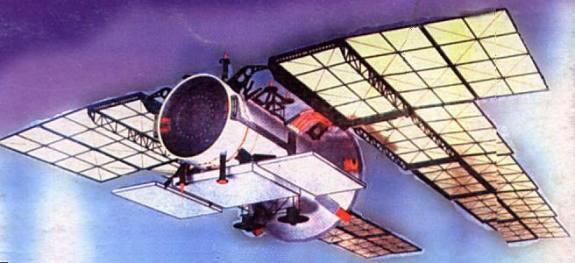
Home - Search - Browse - Alphabetic Index: 0- 1- 2- 3- 4- 5- 6- 7- 8- 9
A- B- C- D- E- F- G- H- I- J- K- L- M- N- O- P- Q- R- S- T- U- V- W- X- Y- Z
Pirs-1

Obzor
Status: Operational 1987. Gross mass: 3,550 kg (7,820 lb).
Pirs was a nuclear-powered active-radar naval targeting spacecraft that was to be equipped with new-generation Topaz reactors and have all-new on-board systems, including electrostatic maneuvering engines, ion orientation / stabilization engines, solar sensors, magnetic momentum compensators, multi-channel wave devices, and special plasma weapons to provide a defense against anti-satellite weapons. However Pirs system was abandoned on the instructions of Gorbachev in 1988. A non-nuclear universal version of the US-P passive satellite went into service in 1993 to accomplish the naval targeting mission.
The RTR active-radar spacecraft had the worst reliability and quality problems of any Soviet system. It was not available often enough for good exploitation of the data. Lessons learned during trials and first operational use resulted in a TTKh specification document for a modernized next generation system. A decree to begin design of this system was issued at the end of 1978. Specifications for the second-generation MKRTs system were developed co-operatively by TZ MO, VMP, GUKOS, and TsNII Kometa (Savin) in 1978-1980. Following approval by NTK and VPK, the development was to have begun in the Eleventh Five Year Plan (1981-1985). A resolution of June 1981 called for completion of a draft project for the Phase 1 Pirs-1 system by the end of 1982.
The complete Ideogramma-Pirs system was to have been deployed during the Twelfth Five year plan (1986-1990). The radio and radiotechnical SIGINT mission of the first generation of naval reconnaissance satellites would be handled by the interservice Tselina-2. The project was given the code name Ideogramma-Pirs. Three OKB's had to collaborate on the draft project due to the use of the new Zenit launch vehicle: NPO Energia, PO Arsenal, and TsKBM. The systems technical specification was delivered to the VMF in September 1982.
Following interagency review, Arsenal presented the draft project to the VPK Military-Industrial Commission on 12 December 1982. Pirs-2 would test the experimental Farvater system with submarine detection capability. General Designer Yu F Valov at PO Arsenal was made responsible in 1983 for the overall space system, while TsNII Kometa solved detailed systems problems. Admiral Gorshkov fiercely resisted relinquishing Navy control of the system despite the desire of the leadership for consolidation of space systems. The overall space system specification was delivered to GUKOS in September 1983, followed by a combined technical proposal.
There were two competing radar systems, from the MRP and MOM industrial sectors. Finally the VMF and GUKOS had to select one for further development for the Phase 1 program. No decision could be made on Phase 2 systems; the competing institutes were instructed to conduct further research to identify the best possible technical solution. A firm program schedule finally emerged in December 1984. Phase 1 was to be deployed by 1990, and Phase 2 by 1993. This decision also finally determined the work distribution between MRP and MOM.
In 1987 two experimental Plazma-A satellites (Cosmos 1818 and 1867) were launched with new-generation Topaz reactors evidently planned for the Pirs-1 and Pirs-2. The spacecraft tested new on-board systems, new elements of the orientation system, and ion engines. Use of a new high radiation-safety orbit was also demonstrated. The Topaz used a new thermo-emission conversion method to convert heat to electricity. This would also power a range of new systems including electrostatic maneuvering engines, ion orientation / stabilization engines, solar sensors, magnetic momentum compensators, multi-channel wave devices, and special plasma weapons to provide a defense against anti-satellite weapons. The Plazma-A satellites carried instruments to map the magnetic field of the earth, with an eye toward developing a magnetic navigation system. Topaz provided over 10 kW of power and had long endurance and storage in a radiation-safe orbit. A follow-on Plazma-2 would have been equipped with the even safer Topaz-2. The spacecraft would be orbited by a Tsyklon 2 booster and have a mass of 3550 kg. Despite these encouraging tests, the nuclear-powered component of the Pirs system was abandoned on the instructions of Gorbachev in 1988 due to continued reliability problems and international incidents when the reactor cores of the satellites crashed to the earth.
The nuclear-powered component of the Pirs system was abandoned in 1988 after a few test flights due to continued reliability problems and international incidents when the reactor cores of the satellites inadvertently crashed to the earth. Modernized versions of the US-P naval electronic reconnaissance and targeting satellites continued in use, stationed at 120 degree intervals on the same orbit with a 0 degree ascending node.
Family: Medium earth orbit, Naval radarsat, Surveillance. Country: Russia. Agency: MO, Arsenal. Bibliography: 102, 2, 445, 6.
Back to top of page
Home - Search - Browse - Alphabetic Index: 0- 1- 2- 3- 4- 5- 6- 7- 8- 9
A- B- C- D- E- F- G- H- I- J- K- L- M- N- O- P- Q- R- S- T- U- V- W- X- Y- Z
© 1997-2019 Mark Wade - Contact
© / Conditions for Use